Next Clothing: Macro-Environment & Strategy Report (BUS 300)
VerifiedAdded on 2021/01/02
|12
|4016
|434
Report
AI Summary
This report provides a strategic analysis of Next Clothing, a British multinational retailer. It begins with an introduction to strategy and its importance for achieving business objectives, followed by an examination of macro-environmental factors using PESTLE analysis, including political, economic, social, technological, legal, and environmental influences. The report then assesses Next Clothing's industry position using Porter's Five Forces, evaluating the threat of new entrants, rivalry among existing firms, bargaining power of suppliers and buyers, and the threat of substitutes. The analysis continues with an evaluation of the company's internal resources and capabilities using the VRIO framework, assessing value, rarity, imitability, and organization. Finally, the report considers stakeholder perspectives and concludes with a summary of the key findings and strategic implications for Next Clothing, highlighting the importance of adapting to external changes and leveraging internal strengths for sustained competitive advantage in the retail sector. The report emphasizes the need for Next Clothing to adapt to external changes and leverage internal strengths for sustained competitive advantage.

ORGANISATIONAL
STRATEGY
STRATEGY
Paraphrase This Document
Need a fresh take? Get an instant paraphrase of this document with our AI Paraphraser
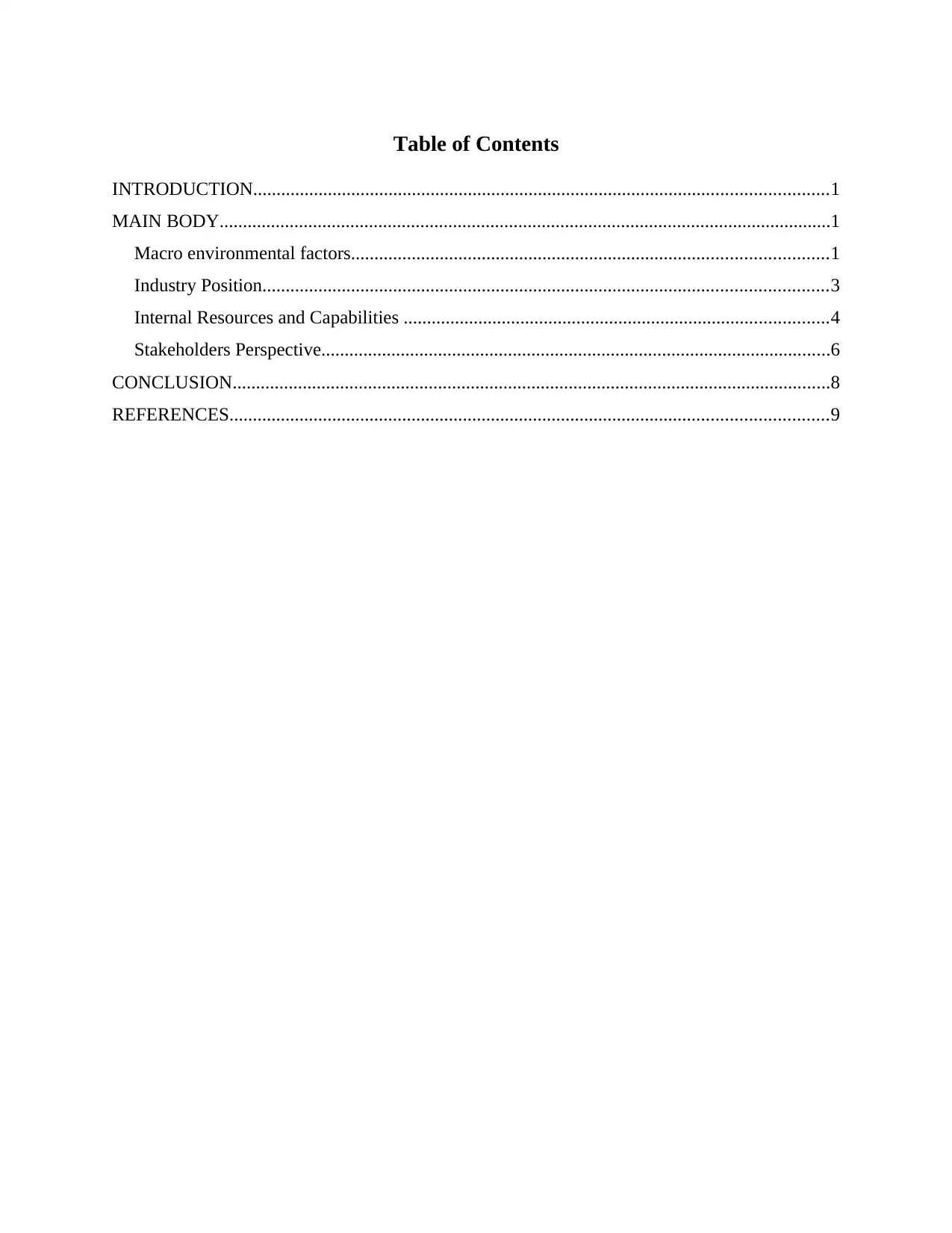
Table of Contents
INTRODUCTION...........................................................................................................................1
MAIN BODY...................................................................................................................................1
Macro environmental factors......................................................................................................1
Industry Position.........................................................................................................................3
Internal Resources and Capabilities ...........................................................................................4
Stakeholders Perspective.............................................................................................................6
CONCLUSION................................................................................................................................8
REFERENCES................................................................................................................................9
INTRODUCTION...........................................................................................................................1
MAIN BODY...................................................................................................................................1
Macro environmental factors......................................................................................................1
Industry Position.........................................................................................................................3
Internal Resources and Capabilities ...........................................................................................4
Stakeholders Perspective.............................................................................................................6
CONCLUSION................................................................................................................................8
REFERENCES................................................................................................................................9

INTRODUCTION
Strategy can be referred to as plan of actions which are formulated in order to accomplish
desired business objectives. An effective strategy supports an organisation in achieving success.
It also assists business entity in gaining competitive advantage. Strategies are also developed by
manager in order to provide an appropriate response to changes in external business environment
which is very much crucial for maintaining long term sustainability. Proper strategic planning is
essential in order to drive an enterprise towards business goals. Strategic planning is complete
based on the mission and vision of firm.
The report have focus on analysing the macro environmental factors which can influence
or plan of Next clothing company. It also emphasizes on analysing the internal resources and
capabilities of an organisation. Study will include some strategic tools such as Pestle for
measuring the effect of changes in external environmental factor on business.
MAIN BODY
Macro environmental factors
Macro environmental factors can be referred to as the external variables or forces which
can have both positive and negative effect on working or business operations of Next clothing.
Changes in macro environmental variables such as social, technological, political etc. have great
influence on business plan as well as strategies. It also has great as well as significant effect on
the decision of management in an organisation.
Next Plc is British multinational organisation operating business in retail sector. Business
entity offers various products such as clothes, home products etc. As company is operating
business globally changes in macro environmental factor can have direct effect on the business
operations of an enterprise. It is required by manager in Next clothing to use strategic tool such
as Pestle, as this will assist management in identifying those factors which can have impact on
the business as well as influence on organisational plans (Burt, Johansson and Dawson, 2017).
Manager in Next clothing should develop suitable strategies as this will support an organisation
in providing quick responses to changes in external environmental constituents. In context of
Next clothing, few factors which can have impact on business operation of company are :
Political factors: these variables includes changes in laws and regulation related to the
clothing industry. It also involves political situation in the nation. Changes in political factors
1
Strategy can be referred to as plan of actions which are formulated in order to accomplish
desired business objectives. An effective strategy supports an organisation in achieving success.
It also assists business entity in gaining competitive advantage. Strategies are also developed by
manager in order to provide an appropriate response to changes in external business environment
which is very much crucial for maintaining long term sustainability. Proper strategic planning is
essential in order to drive an enterprise towards business goals. Strategic planning is complete
based on the mission and vision of firm.
The report have focus on analysing the macro environmental factors which can influence
or plan of Next clothing company. It also emphasizes on analysing the internal resources and
capabilities of an organisation. Study will include some strategic tools such as Pestle for
measuring the effect of changes in external environmental factor on business.
MAIN BODY
Macro environmental factors
Macro environmental factors can be referred to as the external variables or forces which
can have both positive and negative effect on working or business operations of Next clothing.
Changes in macro environmental variables such as social, technological, political etc. have great
influence on business plan as well as strategies. It also has great as well as significant effect on
the decision of management in an organisation.
Next Plc is British multinational organisation operating business in retail sector. Business
entity offers various products such as clothes, home products etc. As company is operating
business globally changes in macro environmental factor can have direct effect on the business
operations of an enterprise. It is required by manager in Next clothing to use strategic tool such
as Pestle, as this will assist management in identifying those factors which can have impact on
the business as well as influence on organisational plans (Burt, Johansson and Dawson, 2017).
Manager in Next clothing should develop suitable strategies as this will support an organisation
in providing quick responses to changes in external environmental constituents. In context of
Next clothing, few factors which can have impact on business operation of company are :
Political factors: these variables includes changes in laws and regulation related to the
clothing industry. It also involves political situation in the nation. Changes in political factors
1
⊘ This is a preview!⊘
Do you want full access?
Subscribe today to unlock all pages.

Trusted by 1+ million students worldwide
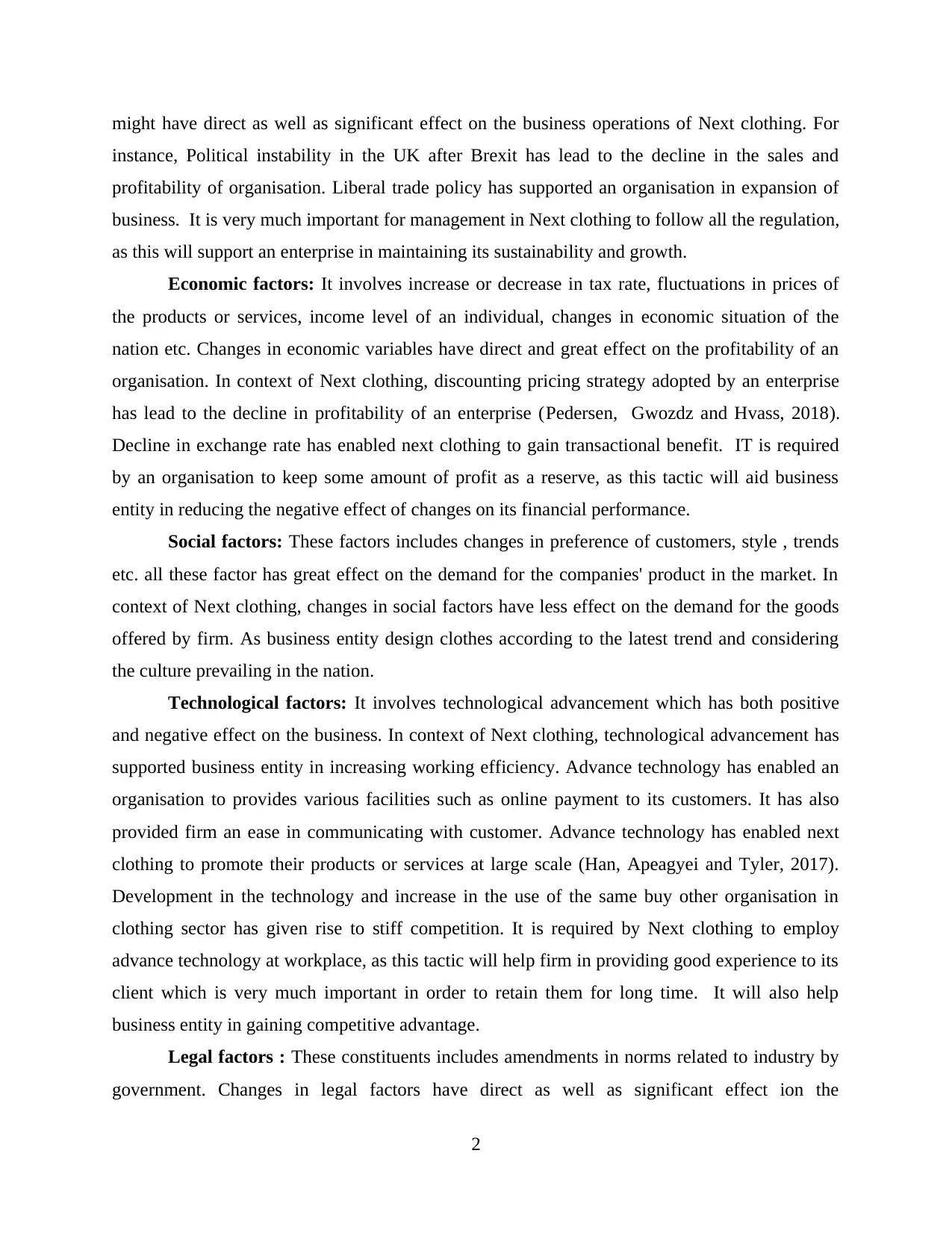
might have direct as well as significant effect on the business operations of Next clothing. For
instance, Political instability in the UK after Brexit has lead to the decline in the sales and
profitability of organisation. Liberal trade policy has supported an organisation in expansion of
business. It is very much important for management in Next clothing to follow all the regulation,
as this will support an enterprise in maintaining its sustainability and growth.
Economic factors: It involves increase or decrease in tax rate, fluctuations in prices of
the products or services, income level of an individual, changes in economic situation of the
nation etc. Changes in economic variables have direct and great effect on the profitability of an
organisation. In context of Next clothing, discounting pricing strategy adopted by an enterprise
has lead to the decline in profitability of an enterprise (Pedersen, Gwozdz and Hvass, 2018).
Decline in exchange rate has enabled next clothing to gain transactional benefit. IT is required
by an organisation to keep some amount of profit as a reserve, as this tactic will aid business
entity in reducing the negative effect of changes on its financial performance.
Social factors: These factors includes changes in preference of customers, style , trends
etc. all these factor has great effect on the demand for the companies' product in the market. In
context of Next clothing, changes in social factors have less effect on the demand for the goods
offered by firm. As business entity design clothes according to the latest trend and considering
the culture prevailing in the nation.
Technological factors: It involves technological advancement which has both positive
and negative effect on the business. In context of Next clothing, technological advancement has
supported business entity in increasing working efficiency. Advance technology has enabled an
organisation to provides various facilities such as online payment to its customers. It has also
provided firm an ease in communicating with customer. Advance technology has enabled next
clothing to promote their products or services at large scale (Han, Apeagyei and Tyler, 2017).
Development in the technology and increase in the use of the same buy other organisation in
clothing sector has given rise to stiff competition. It is required by Next clothing to employ
advance technology at workplace, as this tactic will help firm in providing good experience to its
client which is very much important in order to retain them for long time. It will also help
business entity in gaining competitive advantage.
Legal factors : These constituents includes amendments in norms related to industry by
government. Changes in legal factors have direct as well as significant effect ion the
2
instance, Political instability in the UK after Brexit has lead to the decline in the sales and
profitability of organisation. Liberal trade policy has supported an organisation in expansion of
business. It is very much important for management in Next clothing to follow all the regulation,
as this will support an enterprise in maintaining its sustainability and growth.
Economic factors: It involves increase or decrease in tax rate, fluctuations in prices of
the products or services, income level of an individual, changes in economic situation of the
nation etc. Changes in economic variables have direct and great effect on the profitability of an
organisation. In context of Next clothing, discounting pricing strategy adopted by an enterprise
has lead to the decline in profitability of an enterprise (Pedersen, Gwozdz and Hvass, 2018).
Decline in exchange rate has enabled next clothing to gain transactional benefit. IT is required
by an organisation to keep some amount of profit as a reserve, as this tactic will aid business
entity in reducing the negative effect of changes on its financial performance.
Social factors: These factors includes changes in preference of customers, style , trends
etc. all these factor has great effect on the demand for the companies' product in the market. In
context of Next clothing, changes in social factors have less effect on the demand for the goods
offered by firm. As business entity design clothes according to the latest trend and considering
the culture prevailing in the nation.
Technological factors: It involves technological advancement which has both positive
and negative effect on the business. In context of Next clothing, technological advancement has
supported business entity in increasing working efficiency. Advance technology has enabled an
organisation to provides various facilities such as online payment to its customers. It has also
provided firm an ease in communicating with customer. Advance technology has enabled next
clothing to promote their products or services at large scale (Han, Apeagyei and Tyler, 2017).
Development in the technology and increase in the use of the same buy other organisation in
clothing sector has given rise to stiff competition. It is required by Next clothing to employ
advance technology at workplace, as this tactic will help firm in providing good experience to its
client which is very much important in order to retain them for long time. It will also help
business entity in gaining competitive advantage.
Legal factors : These constituents includes amendments in norms related to industry by
government. Changes in legal factors have direct as well as significant effect ion the
2
Paraphrase This Document
Need a fresh take? Get an instant paraphrase of this document with our AI Paraphraser
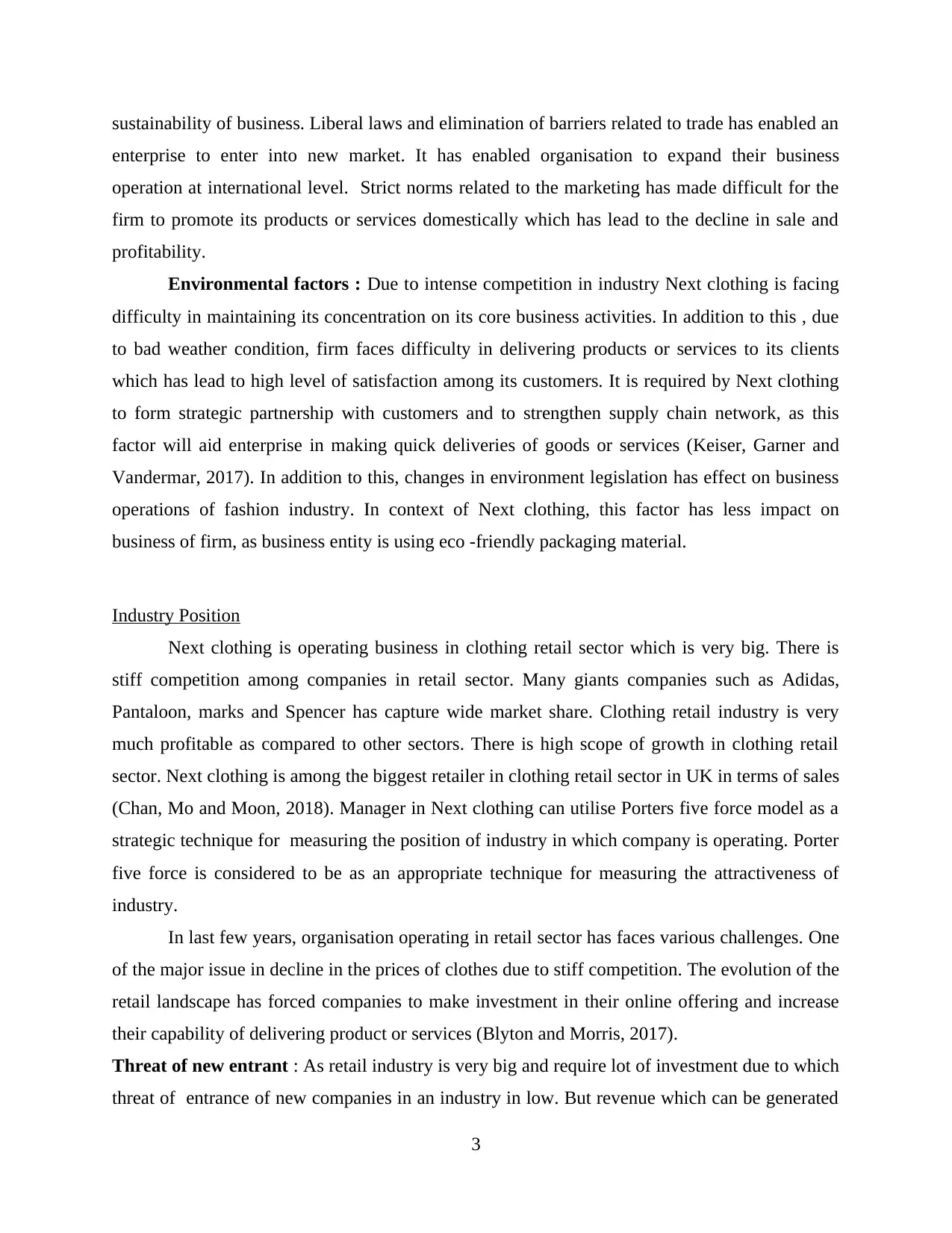
sustainability of business. Liberal laws and elimination of barriers related to trade has enabled an
enterprise to enter into new market. It has enabled organisation to expand their business
operation at international level. Strict norms related to the marketing has made difficult for the
firm to promote its products or services domestically which has lead to the decline in sale and
profitability.
Environmental factors : Due to intense competition in industry Next clothing is facing
difficulty in maintaining its concentration on its core business activities. In addition to this , due
to bad weather condition, firm faces difficulty in delivering products or services to its clients
which has lead to high level of satisfaction among its customers. It is required by Next clothing
to form strategic partnership with customers and to strengthen supply chain network, as this
factor will aid enterprise in making quick deliveries of goods or services (Keiser, Garner and
Vandermar, 2017). In addition to this, changes in environment legislation has effect on business
operations of fashion industry. In context of Next clothing, this factor has less impact on
business of firm, as business entity is using eco -friendly packaging material.
Industry Position
Next clothing is operating business in clothing retail sector which is very big. There is
stiff competition among companies in retail sector. Many giants companies such as Adidas,
Pantaloon, marks and Spencer has capture wide market share. Clothing retail industry is very
much profitable as compared to other sectors. There is high scope of growth in clothing retail
sector. Next clothing is among the biggest retailer in clothing retail sector in UK in terms of sales
(Chan, Mo and Moon, 2018). Manager in Next clothing can utilise Porters five force model as a
strategic technique for measuring the position of industry in which company is operating. Porter
five force is considered to be as an appropriate technique for measuring the attractiveness of
industry.
In last few years, organisation operating in retail sector has faces various challenges. One
of the major issue in decline in the prices of clothes due to stiff competition. The evolution of the
retail landscape has forced companies to make investment in their online offering and increase
their capability of delivering product or services (Blyton and Morris, 2017).
Threat of new entrant : As retail industry is very big and require lot of investment due to which
threat of entrance of new companies in an industry in low. But revenue which can be generated
3
enterprise to enter into new market. It has enabled organisation to expand their business
operation at international level. Strict norms related to the marketing has made difficult for the
firm to promote its products or services domestically which has lead to the decline in sale and
profitability.
Environmental factors : Due to intense competition in industry Next clothing is facing
difficulty in maintaining its concentration on its core business activities. In addition to this , due
to bad weather condition, firm faces difficulty in delivering products or services to its clients
which has lead to high level of satisfaction among its customers. It is required by Next clothing
to form strategic partnership with customers and to strengthen supply chain network, as this
factor will aid enterprise in making quick deliveries of goods or services (Keiser, Garner and
Vandermar, 2017). In addition to this, changes in environment legislation has effect on business
operations of fashion industry. In context of Next clothing, this factor has less impact on
business of firm, as business entity is using eco -friendly packaging material.
Industry Position
Next clothing is operating business in clothing retail sector which is very big. There is
stiff competition among companies in retail sector. Many giants companies such as Adidas,
Pantaloon, marks and Spencer has capture wide market share. Clothing retail industry is very
much profitable as compared to other sectors. There is high scope of growth in clothing retail
sector. Next clothing is among the biggest retailer in clothing retail sector in UK in terms of sales
(Chan, Mo and Moon, 2018). Manager in Next clothing can utilise Porters five force model as a
strategic technique for measuring the position of industry in which company is operating. Porter
five force is considered to be as an appropriate technique for measuring the attractiveness of
industry.
In last few years, organisation operating in retail sector has faces various challenges. One
of the major issue in decline in the prices of clothes due to stiff competition. The evolution of the
retail landscape has forced companies to make investment in their online offering and increase
their capability of delivering product or services (Blyton and Morris, 2017).
Threat of new entrant : As retail industry is very big and require lot of investment due to which
threat of entrance of new companies in an industry in low. But revenue which can be generated
3
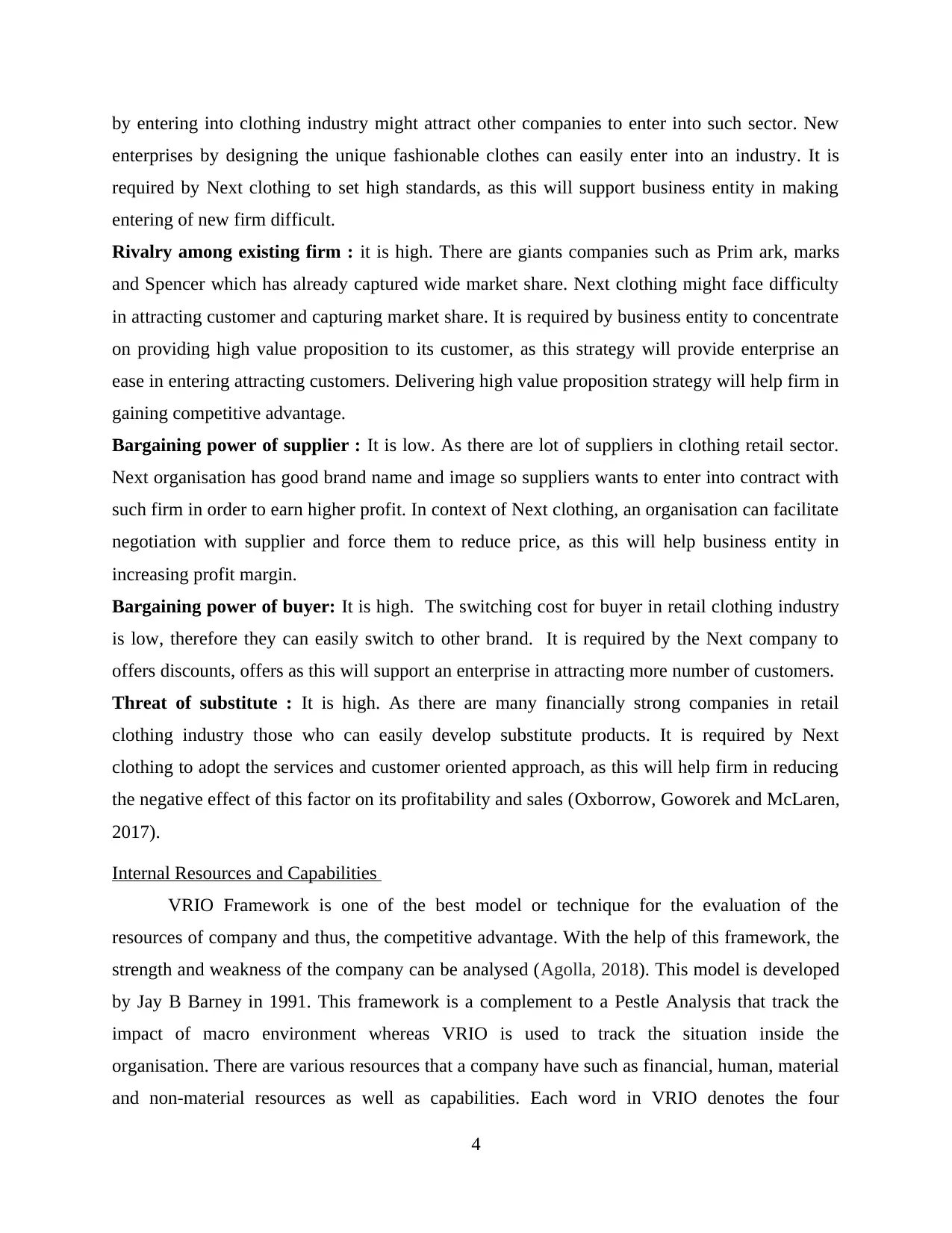
by entering into clothing industry might attract other companies to enter into such sector. New
enterprises by designing the unique fashionable clothes can easily enter into an industry. It is
required by Next clothing to set high standards, as this will support business entity in making
entering of new firm difficult.
Rivalry among existing firm : it is high. There are giants companies such as Prim ark, marks
and Spencer which has already captured wide market share. Next clothing might face difficulty
in attracting customer and capturing market share. It is required by business entity to concentrate
on providing high value proposition to its customer, as this strategy will provide enterprise an
ease in entering attracting customers. Delivering high value proposition strategy will help firm in
gaining competitive advantage.
Bargaining power of supplier : It is low. As there are lot of suppliers in clothing retail sector.
Next organisation has good brand name and image so suppliers wants to enter into contract with
such firm in order to earn higher profit. In context of Next clothing, an organisation can facilitate
negotiation with supplier and force them to reduce price, as this will help business entity in
increasing profit margin.
Bargaining power of buyer: It is high. The switching cost for buyer in retail clothing industry
is low, therefore they can easily switch to other brand. It is required by the Next company to
offers discounts, offers as this will support an enterprise in attracting more number of customers.
Threat of substitute : It is high. As there are many financially strong companies in retail
clothing industry those who can easily develop substitute products. It is required by Next
clothing to adopt the services and customer oriented approach, as this will help firm in reducing
the negative effect of this factor on its profitability and sales (Oxborrow, Goworek and McLaren,
2017).
Internal Resources and Capabilities
VRIO Framework is one of the best model or technique for the evaluation of the
resources of company and thus, the competitive advantage. With the help of this framework, the
strength and weakness of the company can be analysed (Agolla, 2018). This model is developed
by Jay B Barney in 1991. This framework is a complement to a Pestle Analysis that track the
impact of macro environment whereas VRIO is used to track the situation inside the
organisation. There are various resources that a company have such as financial, human, material
and non-material resources as well as capabilities. Each word in VRIO denotes the four
4
enterprises by designing the unique fashionable clothes can easily enter into an industry. It is
required by Next clothing to set high standards, as this will support business entity in making
entering of new firm difficult.
Rivalry among existing firm : it is high. There are giants companies such as Prim ark, marks
and Spencer which has already captured wide market share. Next clothing might face difficulty
in attracting customer and capturing market share. It is required by business entity to concentrate
on providing high value proposition to its customer, as this strategy will provide enterprise an
ease in entering attracting customers. Delivering high value proposition strategy will help firm in
gaining competitive advantage.
Bargaining power of supplier : It is low. As there are lot of suppliers in clothing retail sector.
Next organisation has good brand name and image so suppliers wants to enter into contract with
such firm in order to earn higher profit. In context of Next clothing, an organisation can facilitate
negotiation with supplier and force them to reduce price, as this will help business entity in
increasing profit margin.
Bargaining power of buyer: It is high. The switching cost for buyer in retail clothing industry
is low, therefore they can easily switch to other brand. It is required by the Next company to
offers discounts, offers as this will support an enterprise in attracting more number of customers.
Threat of substitute : It is high. As there are many financially strong companies in retail
clothing industry those who can easily develop substitute products. It is required by Next
clothing to adopt the services and customer oriented approach, as this will help firm in reducing
the negative effect of this factor on its profitability and sales (Oxborrow, Goworek and McLaren,
2017).
Internal Resources and Capabilities
VRIO Framework is one of the best model or technique for the evaluation of the
resources of company and thus, the competitive advantage. With the help of this framework, the
strength and weakness of the company can be analysed (Agolla, 2018). This model is developed
by Jay B Barney in 1991. This framework is a complement to a Pestle Analysis that track the
impact of macro environment whereas VRIO is used to track the situation inside the
organisation. There are various resources that a company have such as financial, human, material
and non-material resources as well as capabilities. Each word in VRIO denotes the four
4
⊘ This is a preview!⊘
Do you want full access?
Subscribe today to unlock all pages.

Trusted by 1+ million students worldwide
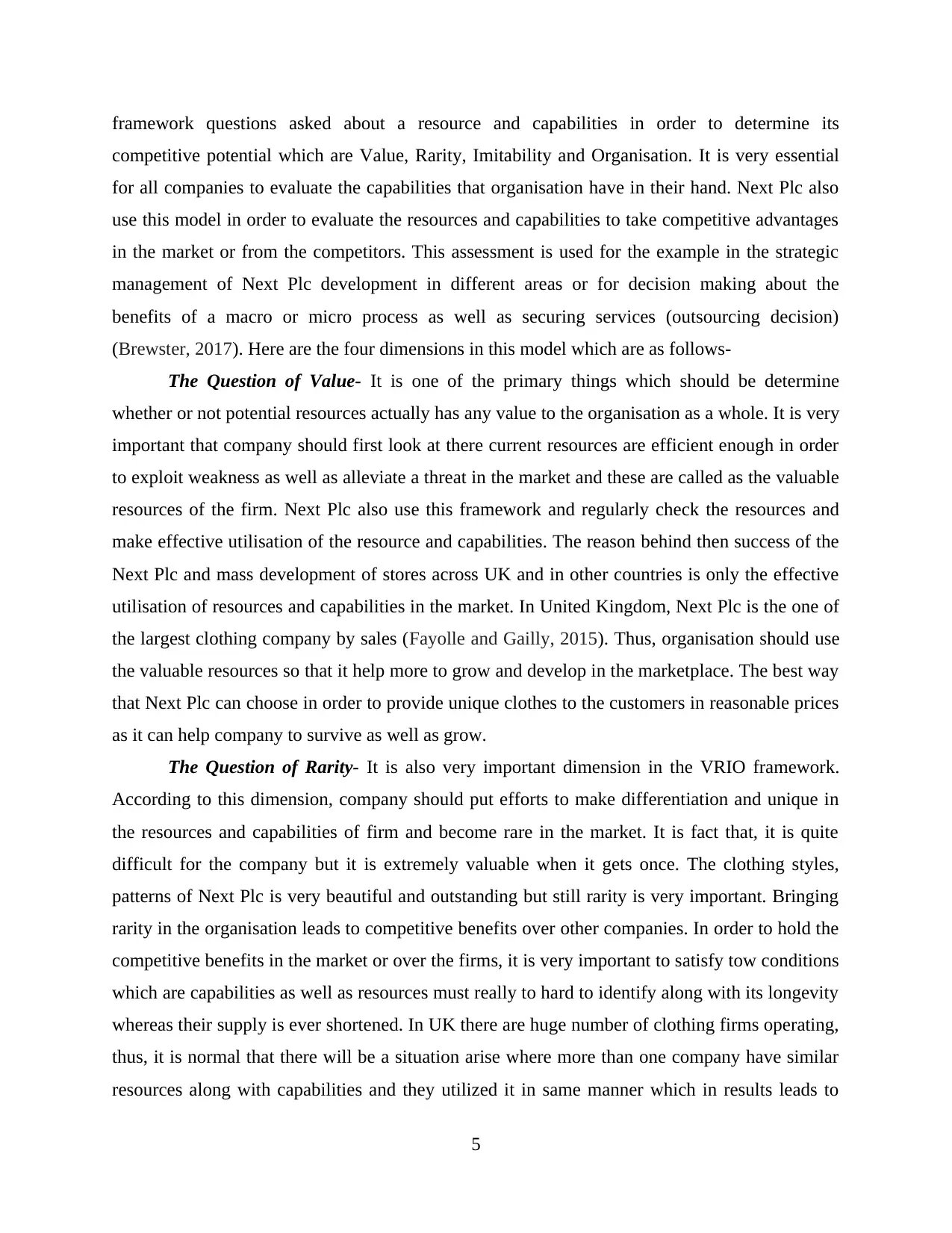
framework questions asked about a resource and capabilities in order to determine its
competitive potential which are Value, Rarity, Imitability and Organisation. It is very essential
for all companies to evaluate the capabilities that organisation have in their hand. Next Plc also
use this model in order to evaluate the resources and capabilities to take competitive advantages
in the market or from the competitors. This assessment is used for the example in the strategic
management of Next Plc development in different areas or for decision making about the
benefits of a macro or micro process as well as securing services (outsourcing decision)
(Brewster, 2017). Here are the four dimensions in this model which are as follows-
The Question of Value- It is one of the primary things which should be determine
whether or not potential resources actually has any value to the organisation as a whole. It is very
important that company should first look at there current resources are efficient enough in order
to exploit weakness as well as alleviate a threat in the market and these are called as the valuable
resources of the firm. Next Plc also use this framework and regularly check the resources and
make effective utilisation of the resource and capabilities. The reason behind then success of the
Next Plc and mass development of stores across UK and in other countries is only the effective
utilisation of resources and capabilities in the market. In United Kingdom, Next Plc is the one of
the largest clothing company by sales (Fayolle and Gailly, 2015). Thus, organisation should use
the valuable resources so that it help more to grow and develop in the marketplace. The best way
that Next Plc can choose in order to provide unique clothes to the customers in reasonable prices
as it can help company to survive as well as grow.
The Question of Rarity- It is also very important dimension in the VRIO framework.
According to this dimension, company should put efforts to make differentiation and unique in
the resources and capabilities of firm and become rare in the market. It is fact that, it is quite
difficult for the company but it is extremely valuable when it gets once. The clothing styles,
patterns of Next Plc is very beautiful and outstanding but still rarity is very important. Bringing
rarity in the organisation leads to competitive benefits over other companies. In order to hold the
competitive benefits in the market or over the firms, it is very important to satisfy tow conditions
which are capabilities as well as resources must really to hard to identify along with its longevity
whereas their supply is ever shortened. In UK there are huge number of clothing firms operating,
thus, it is normal that there will be a situation arise where more than one company have similar
resources along with capabilities and they utilized it in same manner which in results leads to
5
competitive potential which are Value, Rarity, Imitability and Organisation. It is very essential
for all companies to evaluate the capabilities that organisation have in their hand. Next Plc also
use this model in order to evaluate the resources and capabilities to take competitive advantages
in the market or from the competitors. This assessment is used for the example in the strategic
management of Next Plc development in different areas or for decision making about the
benefits of a macro or micro process as well as securing services (outsourcing decision)
(Brewster, 2017). Here are the four dimensions in this model which are as follows-
The Question of Value- It is one of the primary things which should be determine
whether or not potential resources actually has any value to the organisation as a whole. It is very
important that company should first look at there current resources are efficient enough in order
to exploit weakness as well as alleviate a threat in the market and these are called as the valuable
resources of the firm. Next Plc also use this framework and regularly check the resources and
make effective utilisation of the resource and capabilities. The reason behind then success of the
Next Plc and mass development of stores across UK and in other countries is only the effective
utilisation of resources and capabilities in the market. In United Kingdom, Next Plc is the one of
the largest clothing company by sales (Fayolle and Gailly, 2015). Thus, organisation should use
the valuable resources so that it help more to grow and develop in the marketplace. The best way
that Next Plc can choose in order to provide unique clothes to the customers in reasonable prices
as it can help company to survive as well as grow.
The Question of Rarity- It is also very important dimension in the VRIO framework.
According to this dimension, company should put efforts to make differentiation and unique in
the resources and capabilities of firm and become rare in the market. It is fact that, it is quite
difficult for the company but it is extremely valuable when it gets once. The clothing styles,
patterns of Next Plc is very beautiful and outstanding but still rarity is very important. Bringing
rarity in the organisation leads to competitive benefits over other companies. In order to hold the
competitive benefits in the market or over the firms, it is very important to satisfy tow conditions
which are capabilities as well as resources must really to hard to identify along with its longevity
whereas their supply is ever shortened. In UK there are huge number of clothing firms operating,
thus, it is normal that there will be a situation arise where more than one company have similar
resources along with capabilities and they utilized it in same manner which in results leads to
5
Paraphrase This Document
Need a fresh take? Get an instant paraphrase of this document with our AI Paraphraser
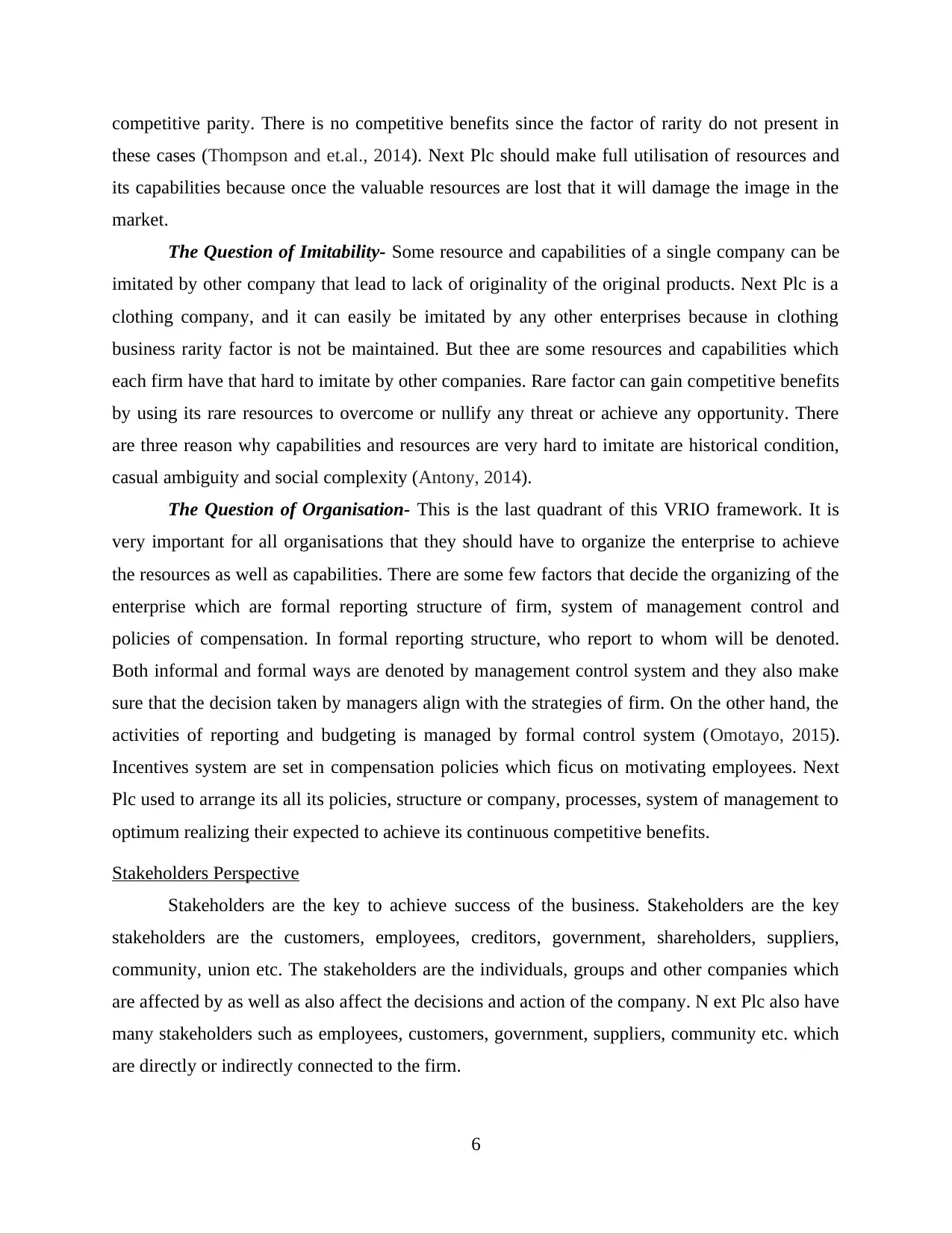
competitive parity. There is no competitive benefits since the factor of rarity do not present in
these cases (Thompson and et.al., 2014). Next Plc should make full utilisation of resources and
its capabilities because once the valuable resources are lost that it will damage the image in the
market.
The Question of Imitability- Some resource and capabilities of a single company can be
imitated by other company that lead to lack of originality of the original products. Next Plc is a
clothing company, and it can easily be imitated by any other enterprises because in clothing
business rarity factor is not be maintained. But thee are some resources and capabilities which
each firm have that hard to imitate by other companies. Rare factor can gain competitive benefits
by using its rare resources to overcome or nullify any threat or achieve any opportunity. There
are three reason why capabilities and resources are very hard to imitate are historical condition,
casual ambiguity and social complexity (Antony, 2014).
The Question of Organisation- This is the last quadrant of this VRIO framework. It is
very important for all organisations that they should have to organize the enterprise to achieve
the resources as well as capabilities. There are some few factors that decide the organizing of the
enterprise which are formal reporting structure of firm, system of management control and
policies of compensation. In formal reporting structure, who report to whom will be denoted.
Both informal and formal ways are denoted by management control system and they also make
sure that the decision taken by managers align with the strategies of firm. On the other hand, the
activities of reporting and budgeting is managed by formal control system (Omotayo, 2015).
Incentives system are set in compensation policies which ficus on motivating employees. Next
Plc used to arrange its all its policies, structure or company, processes, system of management to
optimum realizing their expected to achieve its continuous competitive benefits.
Stakeholders Perspective
Stakeholders are the key to achieve success of the business. Stakeholders are the key
stakeholders are the customers, employees, creditors, government, shareholders, suppliers,
community, union etc. The stakeholders are the individuals, groups and other companies which
are affected by as well as also affect the decisions and action of the company. N ext Plc also have
many stakeholders such as employees, customers, government, suppliers, community etc. which
are directly or indirectly connected to the firm.
6
these cases (Thompson and et.al., 2014). Next Plc should make full utilisation of resources and
its capabilities because once the valuable resources are lost that it will damage the image in the
market.
The Question of Imitability- Some resource and capabilities of a single company can be
imitated by other company that lead to lack of originality of the original products. Next Plc is a
clothing company, and it can easily be imitated by any other enterprises because in clothing
business rarity factor is not be maintained. But thee are some resources and capabilities which
each firm have that hard to imitate by other companies. Rare factor can gain competitive benefits
by using its rare resources to overcome or nullify any threat or achieve any opportunity. There
are three reason why capabilities and resources are very hard to imitate are historical condition,
casual ambiguity and social complexity (Antony, 2014).
The Question of Organisation- This is the last quadrant of this VRIO framework. It is
very important for all organisations that they should have to organize the enterprise to achieve
the resources as well as capabilities. There are some few factors that decide the organizing of the
enterprise which are formal reporting structure of firm, system of management control and
policies of compensation. In formal reporting structure, who report to whom will be denoted.
Both informal and formal ways are denoted by management control system and they also make
sure that the decision taken by managers align with the strategies of firm. On the other hand, the
activities of reporting and budgeting is managed by formal control system (Omotayo, 2015).
Incentives system are set in compensation policies which ficus on motivating employees. Next
Plc used to arrange its all its policies, structure or company, processes, system of management to
optimum realizing their expected to achieve its continuous competitive benefits.
Stakeholders Perspective
Stakeholders are the key to achieve success of the business. Stakeholders are the key
stakeholders are the customers, employees, creditors, government, shareholders, suppliers,
community, union etc. The stakeholders are the individuals, groups and other companies which
are affected by as well as also affect the decisions and action of the company. N ext Plc also have
many stakeholders such as employees, customers, government, suppliers, community etc. which
are directly or indirectly connected to the firm.
6
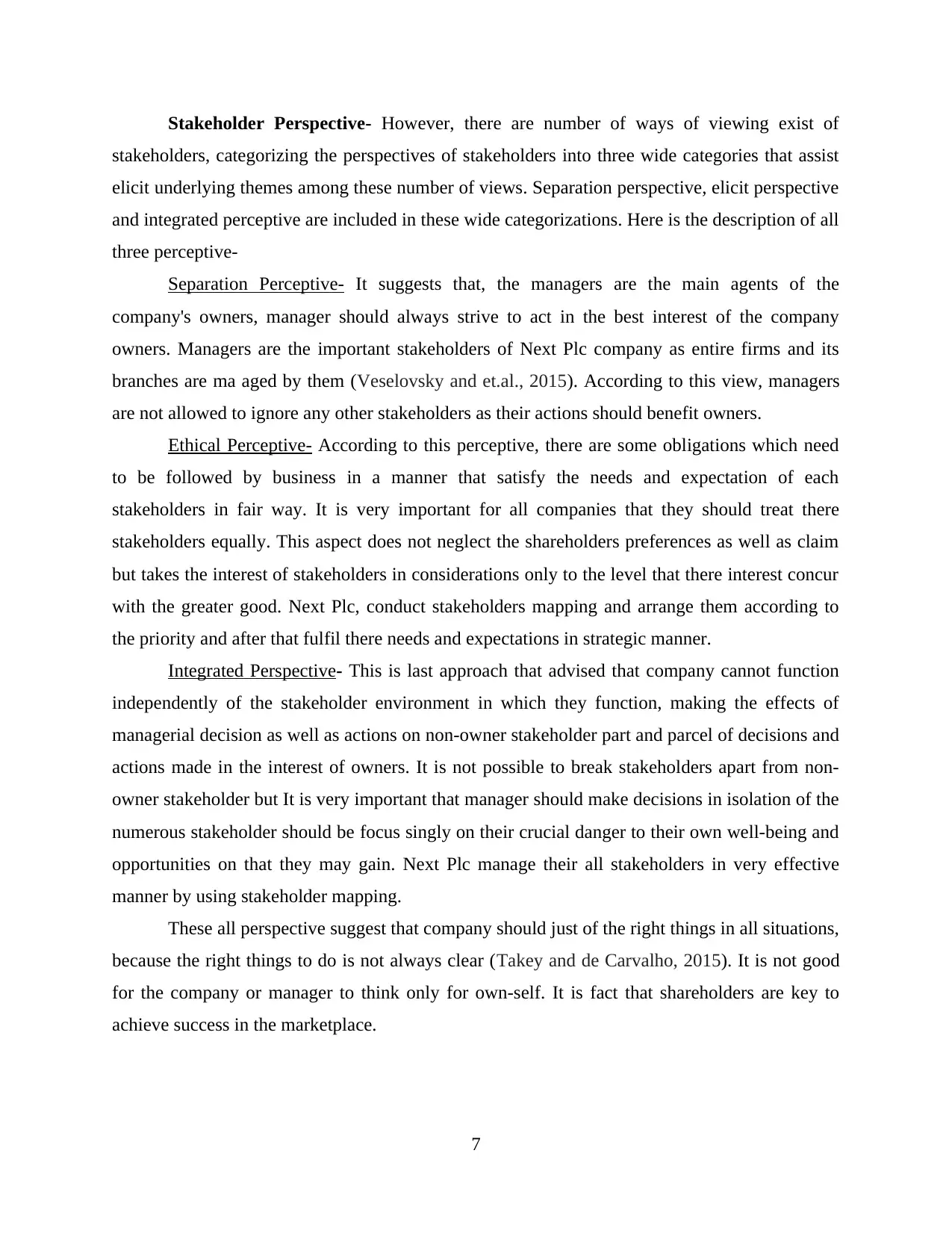
Stakeholder Perspective- However, there are number of ways of viewing exist of
stakeholders, categorizing the perspectives of stakeholders into three wide categories that assist
elicit underlying themes among these number of views. Separation perspective, elicit perspective
and integrated perceptive are included in these wide categorizations. Here is the description of all
three perceptive-
Separation Perceptive- It suggests that, the managers are the main agents of the
company's owners, manager should always strive to act in the best interest of the company
owners. Managers are the important stakeholders of Next Plc company as entire firms and its
branches are ma aged by them (Veselovsky and et.al., 2015). According to this view, managers
are not allowed to ignore any other stakeholders as their actions should benefit owners.
Ethical Perceptive- According to this perceptive, there are some obligations which need
to be followed by business in a manner that satisfy the needs and expectation of each
stakeholders in fair way. It is very important for all companies that they should treat there
stakeholders equally. This aspect does not neglect the shareholders preferences as well as claim
but takes the interest of stakeholders in considerations only to the level that there interest concur
with the greater good. Next Plc, conduct stakeholders mapping and arrange them according to
the priority and after that fulfil there needs and expectations in strategic manner.
Integrated Perspective- This is last approach that advised that company cannot function
independently of the stakeholder environment in which they function, making the effects of
managerial decision as well as actions on non-owner stakeholder part and parcel of decisions and
actions made in the interest of owners. It is not possible to break stakeholders apart from non-
owner stakeholder but It is very important that manager should make decisions in isolation of the
numerous stakeholder should be focus singly on their crucial danger to their own well-being and
opportunities on that they may gain. Next Plc manage their all stakeholders in very effective
manner by using stakeholder mapping.
These all perspective suggest that company should just of the right things in all situations,
because the right things to do is not always clear (Takey and de Carvalho, 2015). It is not good
for the company or manager to think only for own-self. It is fact that shareholders are key to
achieve success in the marketplace.
7
stakeholders, categorizing the perspectives of stakeholders into three wide categories that assist
elicit underlying themes among these number of views. Separation perspective, elicit perspective
and integrated perceptive are included in these wide categorizations. Here is the description of all
three perceptive-
Separation Perceptive- It suggests that, the managers are the main agents of the
company's owners, manager should always strive to act in the best interest of the company
owners. Managers are the important stakeholders of Next Plc company as entire firms and its
branches are ma aged by them (Veselovsky and et.al., 2015). According to this view, managers
are not allowed to ignore any other stakeholders as their actions should benefit owners.
Ethical Perceptive- According to this perceptive, there are some obligations which need
to be followed by business in a manner that satisfy the needs and expectation of each
stakeholders in fair way. It is very important for all companies that they should treat there
stakeholders equally. This aspect does not neglect the shareholders preferences as well as claim
but takes the interest of stakeholders in considerations only to the level that there interest concur
with the greater good. Next Plc, conduct stakeholders mapping and arrange them according to
the priority and after that fulfil there needs and expectations in strategic manner.
Integrated Perspective- This is last approach that advised that company cannot function
independently of the stakeholder environment in which they function, making the effects of
managerial decision as well as actions on non-owner stakeholder part and parcel of decisions and
actions made in the interest of owners. It is not possible to break stakeholders apart from non-
owner stakeholder but It is very important that manager should make decisions in isolation of the
numerous stakeholder should be focus singly on their crucial danger to their own well-being and
opportunities on that they may gain. Next Plc manage their all stakeholders in very effective
manner by using stakeholder mapping.
These all perspective suggest that company should just of the right things in all situations,
because the right things to do is not always clear (Takey and de Carvalho, 2015). It is not good
for the company or manager to think only for own-self. It is fact that shareholders are key to
achieve success in the marketplace.
7
⊘ This is a preview!⊘
Do you want full access?
Subscribe today to unlock all pages.

Trusted by 1+ million students worldwide
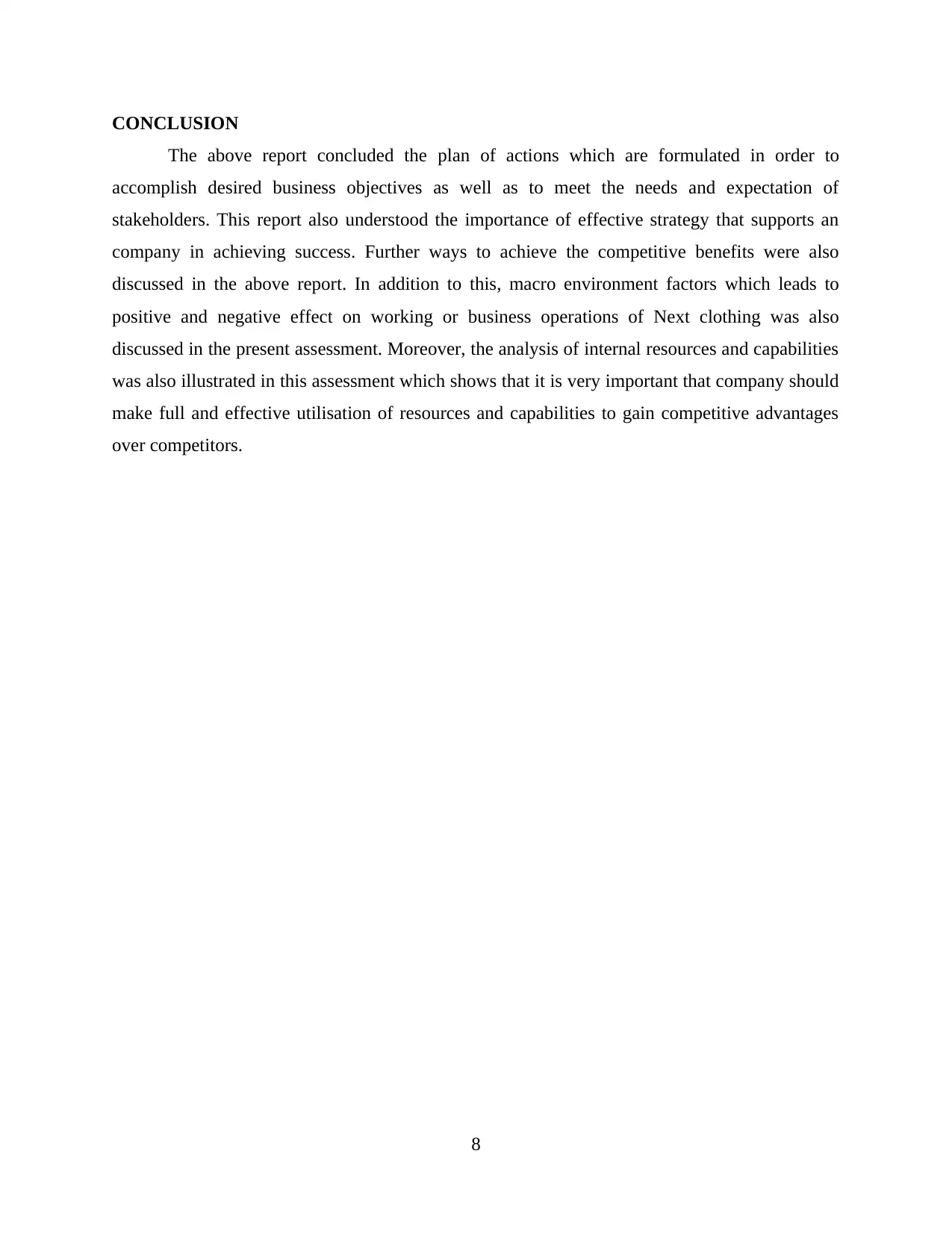
CONCLUSION
The above report concluded the plan of actions which are formulated in order to
accomplish desired business objectives as well as to meet the needs and expectation of
stakeholders. This report also understood the importance of effective strategy that supports an
company in achieving success. Further ways to achieve the competitive benefits were also
discussed in the above report. In addition to this, macro environment factors which leads to
positive and negative effect on working or business operations of Next clothing was also
discussed in the present assessment. Moreover, the analysis of internal resources and capabilities
was also illustrated in this assessment which shows that it is very important that company should
make full and effective utilisation of resources and capabilities to gain competitive advantages
over competitors.
8
The above report concluded the plan of actions which are formulated in order to
accomplish desired business objectives as well as to meet the needs and expectation of
stakeholders. This report also understood the importance of effective strategy that supports an
company in achieving success. Further ways to achieve the competitive benefits were also
discussed in the above report. In addition to this, macro environment factors which leads to
positive and negative effect on working or business operations of Next clothing was also
discussed in the present assessment. Moreover, the analysis of internal resources and capabilities
was also illustrated in this assessment which shows that it is very important that company should
make full and effective utilisation of resources and capabilities to gain competitive advantages
over competitors.
8
Paraphrase This Document
Need a fresh take? Get an instant paraphrase of this document with our AI Paraphraser
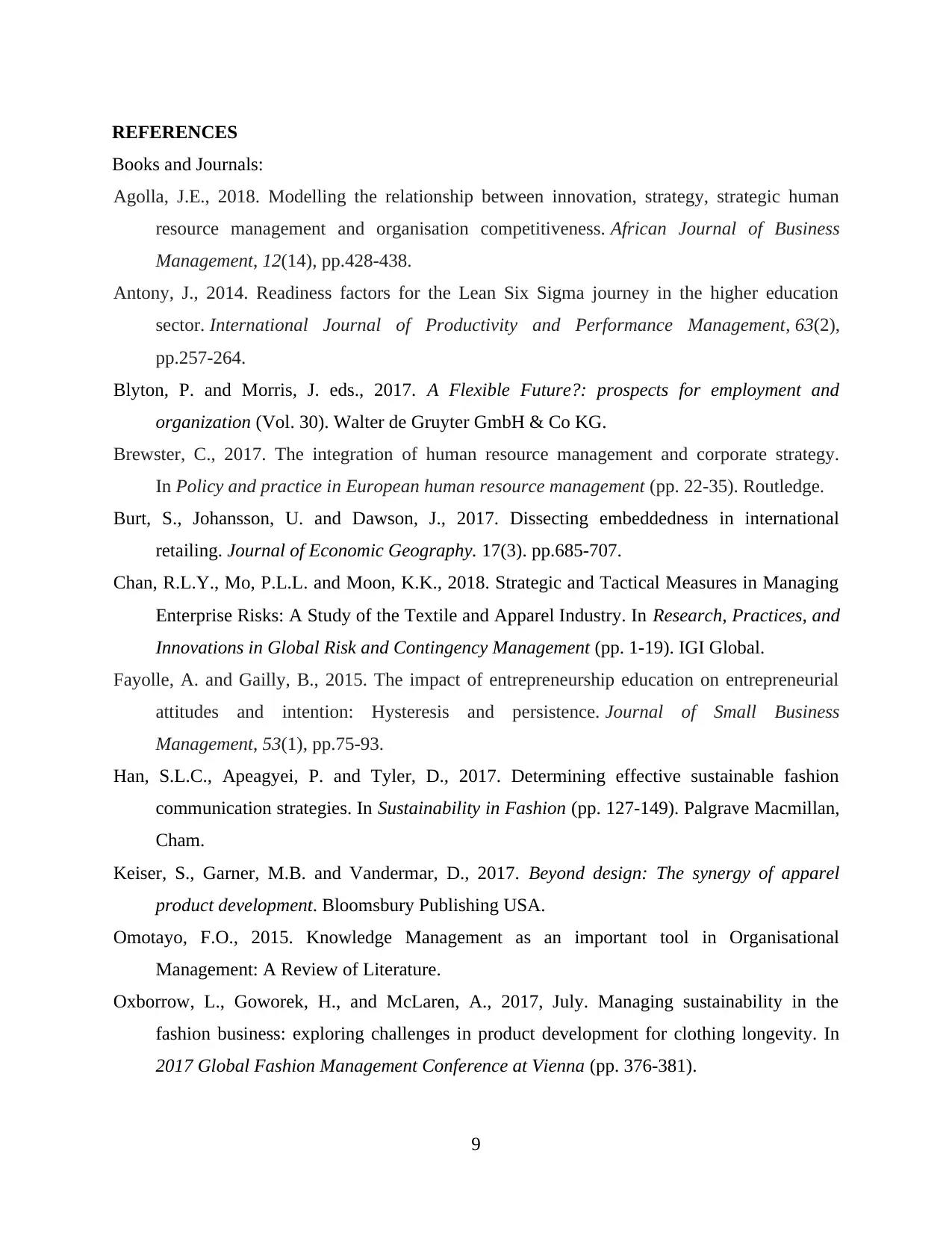
REFERENCES
Books and Journals:
Agolla, J.E., 2018. Modelling the relationship between innovation, strategy, strategic human
resource management and organisation competitiveness. African Journal of Business
Management, 12(14), pp.428-438.
Antony, J., 2014. Readiness factors for the Lean Six Sigma journey in the higher education
sector. International Journal of Productivity and Performance Management, 63(2),
pp.257-264.
Blyton, P. and Morris, J. eds., 2017. A Flexible Future?: prospects for employment and
organization (Vol. 30). Walter de Gruyter GmbH & Co KG.
Brewster, C., 2017. The integration of human resource management and corporate strategy.
In Policy and practice in European human resource management (pp. 22-35). Routledge.
Burt, S., Johansson, U. and Dawson, J., 2017. Dissecting embeddedness in international
retailing. Journal of Economic Geography. 17(3). pp.685-707.
Chan, R.L.Y., Mo, P.L.L. and Moon, K.K., 2018. Strategic and Tactical Measures in Managing
Enterprise Risks: A Study of the Textile and Apparel Industry. In Research, Practices, and
Innovations in Global Risk and Contingency Management (pp. 1-19). IGI Global.
Fayolle, A. and Gailly, B., 2015. The impact of entrepreneurship education on entrepreneurial
attitudes and intention: Hysteresis and persistence. Journal of Small Business
Management, 53(1), pp.75-93.
Han, S.L.C., Apeagyei, P. and Tyler, D., 2017. Determining effective sustainable fashion
communication strategies. In Sustainability in Fashion (pp. 127-149). Palgrave Macmillan,
Cham.
Keiser, S., Garner, M.B. and Vandermar, D., 2017. Beyond design: The synergy of apparel
product development. Bloomsbury Publishing USA.
Omotayo, F.O., 2015. Knowledge Management as an important tool in Organisational
Management: A Review of Literature.
Oxborrow, L., Goworek, H., and McLaren, A., 2017, July. Managing sustainability in the
fashion business: exploring challenges in product development for clothing longevity. In
2017 Global Fashion Management Conference at Vienna (pp. 376-381).
9
Books and Journals:
Agolla, J.E., 2018. Modelling the relationship between innovation, strategy, strategic human
resource management and organisation competitiveness. African Journal of Business
Management, 12(14), pp.428-438.
Antony, J., 2014. Readiness factors for the Lean Six Sigma journey in the higher education
sector. International Journal of Productivity and Performance Management, 63(2),
pp.257-264.
Blyton, P. and Morris, J. eds., 2017. A Flexible Future?: prospects for employment and
organization (Vol. 30). Walter de Gruyter GmbH & Co KG.
Brewster, C., 2017. The integration of human resource management and corporate strategy.
In Policy and practice in European human resource management (pp. 22-35). Routledge.
Burt, S., Johansson, U. and Dawson, J., 2017. Dissecting embeddedness in international
retailing. Journal of Economic Geography. 17(3). pp.685-707.
Chan, R.L.Y., Mo, P.L.L. and Moon, K.K., 2018. Strategic and Tactical Measures in Managing
Enterprise Risks: A Study of the Textile and Apparel Industry. In Research, Practices, and
Innovations in Global Risk and Contingency Management (pp. 1-19). IGI Global.
Fayolle, A. and Gailly, B., 2015. The impact of entrepreneurship education on entrepreneurial
attitudes and intention: Hysteresis and persistence. Journal of Small Business
Management, 53(1), pp.75-93.
Han, S.L.C., Apeagyei, P. and Tyler, D., 2017. Determining effective sustainable fashion
communication strategies. In Sustainability in Fashion (pp. 127-149). Palgrave Macmillan,
Cham.
Keiser, S., Garner, M.B. and Vandermar, D., 2017. Beyond design: The synergy of apparel
product development. Bloomsbury Publishing USA.
Omotayo, F.O., 2015. Knowledge Management as an important tool in Organisational
Management: A Review of Literature.
Oxborrow, L., Goworek, H., and McLaren, A., 2017, July. Managing sustainability in the
fashion business: exploring challenges in product development for clothing longevity. In
2017 Global Fashion Management Conference at Vienna (pp. 376-381).
9
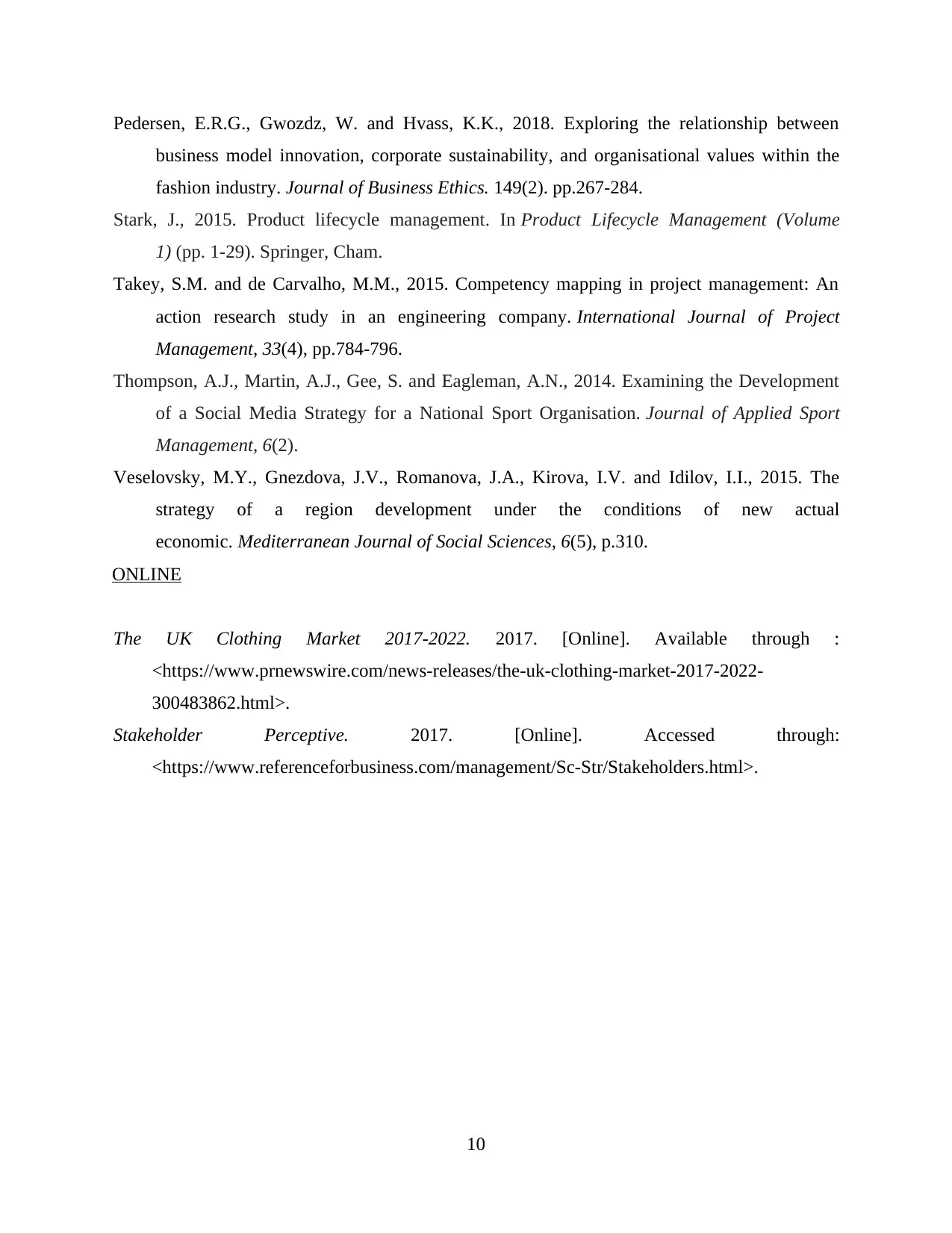
Pedersen, E.R.G., Gwozdz, W. and Hvass, K.K., 2018. Exploring the relationship between
business model innovation, corporate sustainability, and organisational values within the
fashion industry. Journal of Business Ethics. 149(2). pp.267-284.
Stark, J., 2015. Product lifecycle management. In Product Lifecycle Management (Volume
1) (pp. 1-29). Springer, Cham.
Takey, S.M. and de Carvalho, M.M., 2015. Competency mapping in project management: An
action research study in an engineering company. International Journal of Project
Management, 33(4), pp.784-796.
Thompson, A.J., Martin, A.J., Gee, S. and Eagleman, A.N., 2014. Examining the Development
of a Social Media Strategy for a National Sport Organisation. Journal of Applied Sport
Management, 6(2).
Veselovsky, M.Y., Gnezdova, J.V., Romanova, J.A., Kirova, I.V. and Idilov, I.I., 2015. The
strategy of a region development under the conditions of new actual
economic. Mediterranean Journal of Social Sciences, 6(5), p.310.
ONLINE
The UK Clothing Market 2017-2022. 2017. [Online]. Available through :
<https://www.prnewswire.com/news-releases/the-uk-clothing-market-2017-2022-
300483862.html>.
Stakeholder Perceptive. 2017. [Online]. Accessed through:
<https://www.referenceforbusiness.com/management/Sc-Str/Stakeholders.html>.
10
business model innovation, corporate sustainability, and organisational values within the
fashion industry. Journal of Business Ethics. 149(2). pp.267-284.
Stark, J., 2015. Product lifecycle management. In Product Lifecycle Management (Volume
1) (pp. 1-29). Springer, Cham.
Takey, S.M. and de Carvalho, M.M., 2015. Competency mapping in project management: An
action research study in an engineering company. International Journal of Project
Management, 33(4), pp.784-796.
Thompson, A.J., Martin, A.J., Gee, S. and Eagleman, A.N., 2014. Examining the Development
of a Social Media Strategy for a National Sport Organisation. Journal of Applied Sport
Management, 6(2).
Veselovsky, M.Y., Gnezdova, J.V., Romanova, J.A., Kirova, I.V. and Idilov, I.I., 2015. The
strategy of a region development under the conditions of new actual
economic. Mediterranean Journal of Social Sciences, 6(5), p.310.
ONLINE
The UK Clothing Market 2017-2022. 2017. [Online]. Available through :
<https://www.prnewswire.com/news-releases/the-uk-clothing-market-2017-2022-
300483862.html>.
Stakeholder Perceptive. 2017. [Online]. Accessed through:
<https://www.referenceforbusiness.com/management/Sc-Str/Stakeholders.html>.
10
⊘ This is a preview!⊘
Do you want full access?
Subscribe today to unlock all pages.

Trusted by 1+ million students worldwide
1 out of 12
Related Documents
Your All-in-One AI-Powered Toolkit for Academic Success.
+13062052269
info@desklib.com
Available 24*7 on WhatsApp / Email
![[object Object]](/_next/static/media/star-bottom.7253800d.svg)
Unlock your academic potential
Copyright © 2020–2025 A2Z Services. All Rights Reserved. Developed and managed by ZUCOL.





